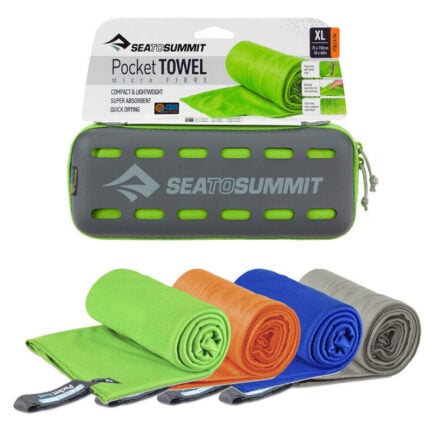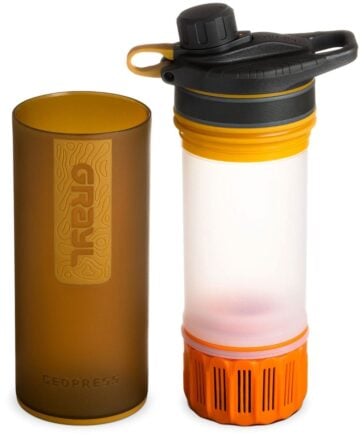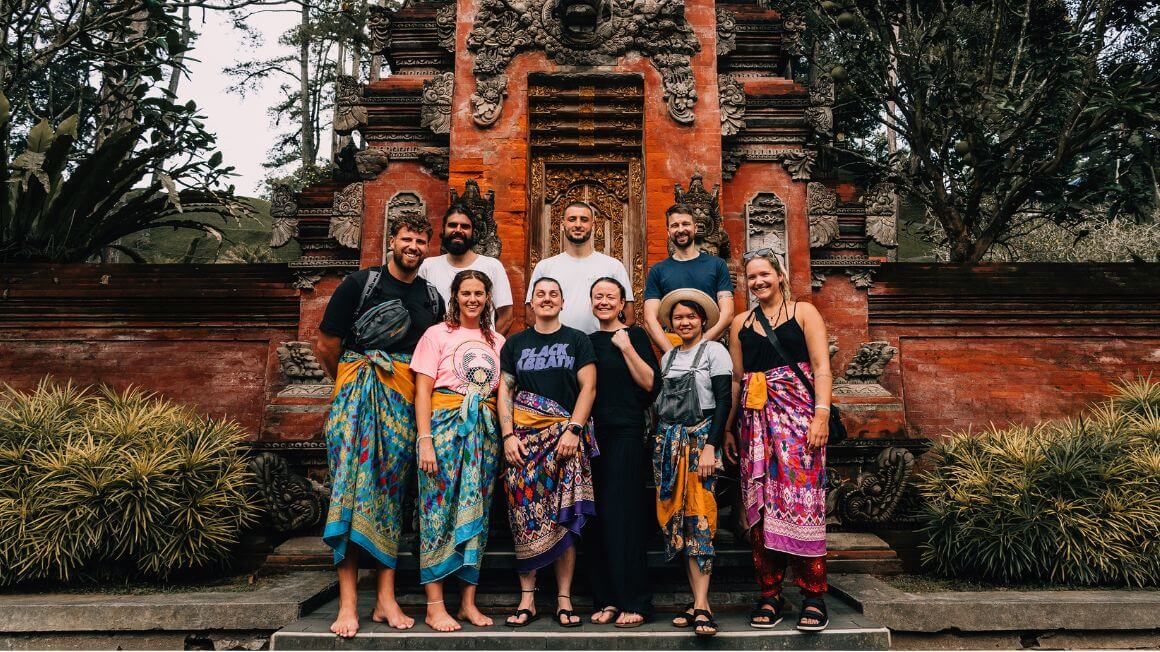The Broke Backpacker is supported by you. Clicking through our links may earn us a small affiliate commission, and that's what allows us to keep producing free content 🙂 Learn more.
I love a good East meets West narrative, the coming together of two cultures, each bringing out the best in each other.
That’s not really the story of Cyprus, though. It’s more the story of East crashes into West, and everyone goes to war, leading to a Mexican stand-off that is now in its 50th year.
Maybe, eventually, the island will get the happy ending that my childhood fairytales assure me comes to all good folk, but for now, the country is in a fascinating state of equilibrium.
Occupying most of the island is the Greek Cyprus, boasting the serenity of the Troodos Mountains, the flashy yachts of Limassol, and the beachside party town of Ayia Napa.
In the northeastern quadrant, you’ve got the Turkish Cyprus, less heavily touristed but offering Crusader castles and unspoiled nature.
The border between the two sides is becoming more and more porous all the time, which means you can get to see two different but connected cultures for the price of one holiday. How’s that for a broke backpacker deal?
- Why Go Backpacking in Cyprus?
- Best Travel Itineraries for Backpacking in Cyprus
- Best Places to Visit in Cyprus
- 8 Top Things to Do in Cyprus
- Backpacker Accommodation in Cyprus
- Cyprus Backpacking Costs
- Best Time to Travel to Cyprus
- Staying Safe in Cyprus
- How to Get Into Cyprus
- How to Get Around Cyprus
- Cypriot Culture
- FAQs About Backpacking in Cyprus
- Final Thoughts on Traveling to Cyprus
- Buy Us a Coffee!
Why Go Backpacking in Cyprus?
The main reason people come to the islands of the Med is for sun, sand and sea – which, obviously, Cyprus has in spades. There are more than 70 Blue Flag beaches spread across this big beast of an island, which is one of the largest in the region.
While the most famous of Cyprus’ beaches are often packed during the summer months – and clogged with guys selling umbrellas and loungers for €7.50 a pop – there are a lot of quieter places you can bum around without spending a penny.
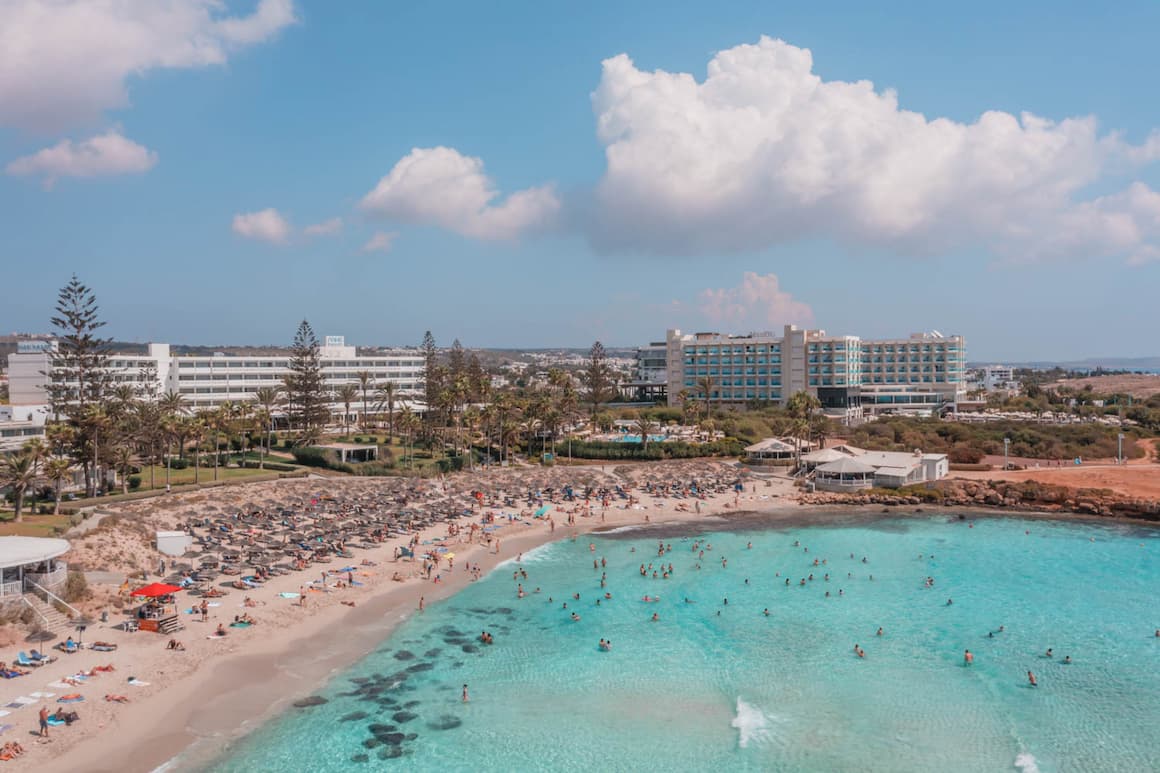
Photo: Mal Hellyer
The Broke Backpacker is supported by you. Clicking through our links may earn us a small affiliate commission, and that's what allows us to keep producing free content 🙂 Learn more.
The temp hovers around a crispy 30 degrees Celsius in the summer months, but spring and autumn are also mild. Basically, it’s the perfect weather for hanging about with other backpackers, shooting the breeze, and sinking a few bottles of KEO beer.
But this country is more than just its coastline, and there are masses of more active stuff you can do on a Cyprus road trip. Some of my best memories are from hiking around the lush interior of the island, which is dotted here and there with hilltop villages plopped down right in the middle of the incredible nature. Honestly, why would you not want to wake up to a view of rolling hills as far as the eye can see?
Head down the slopes, particularly on the western side of the Troodos Mountains, and you’ll find a winemaking scene that’s been going for centuries but has mostly avoided becoming all hoity-toity. Forget the spittoon, I’m here to drink!
I’d be lying if I told you Cyprus is cheap cheap, as in Southeast Asia cheap, but the prices for accommodation and food aren’t bad for a cheaper European vacay. It wouldn’t feature on my list of places to go on a shoestring budget, but a bit of savvy spending can still make your adventures here pretty affordable.
Best Travel Itineraries for Backpacking in Cyprus
If you were renting a car in Cyprus, you could easily pack a wide-ranging trip into 5 days. HOWEVER, that obviously would add quite a bit to your budget – at least $120 a week, even for a tiny little motor. Hardly the broke backpacker ideal!
Going about by public transport is cheaper but a lot slower. So, with that in mind, here’s my perfect intro itinerary for the first-timer.
7-Days Travel Itinerary for Cyprus
There are two main airports in Cyprus, Larnaca and Paphos, located on almost opposite ends of the island. Larnaca is larger, and more airlines fly there, but several budget operators have routes to Paphos.
For this itinerary, I’m going to assume you flew into Larnaca, but just reverse the route if you snap up a sweet deal to Paphos instead.
Larnaca itself isn’t much to shout about, so after the briefest of stays there, head to Ayia Napa. This resort town is surrounded by some of the most beautiful coastlines in Cyprus, from long sandy stretches to rocky cliffs where you can launch yourself into the sea.
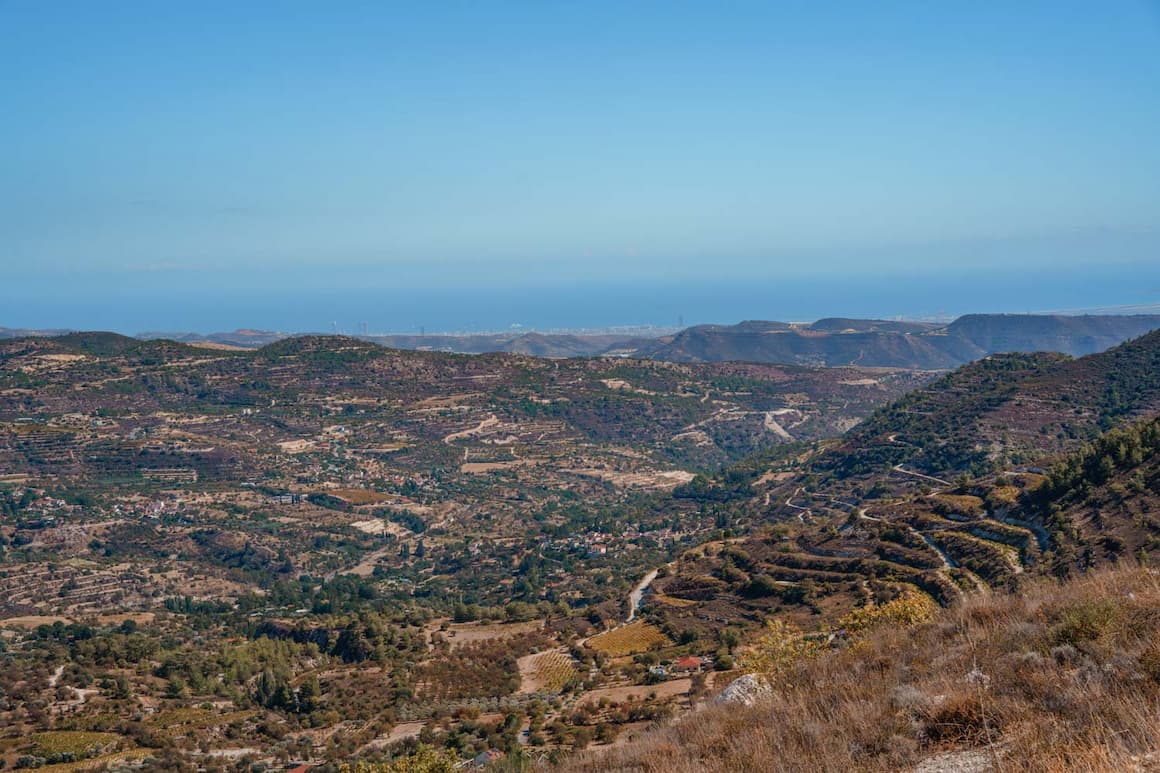
Photo: Mal Hellyer
From there, head north to the capital, Nicosia, crossing the border over into the Turkish side of Cyprus for some delicious food and historic Ottoman architecture.
Stick around in Northern Cyprus for a night or two, enjoying castles and kofte, before hopping back over to Greek Cyprus and driving down towards Limassol for a glimpse of Cypriote high life.
Moving away from the coast, head up into the Troodos Mountains, where bus lines end and epic hikes begin.
Finish up on the east coast of Cyprus, checking out the ancient ruins while staying in Paphos and enjoying some more beach time at Coral Bay or Lara Beach.
Best Places to Visit in Cyprus
I’d broadly divide the things to do in Cyprus into three main areas: city, seaside, and mountains.
For culture and history, Nicosia and Paphos are fascinating little snapshots of Cyprus. Both played an important part in the island’s past (I’ll get the history textbook out later), but they have also evolved into modern cities where a lot of the nation’s youth work and play.
The beach, well, I probably don’t need to tell you how sitting on sun-kissed shores can be soothing for the soul! There are also water sports and coves for snorkeling once you’ve reached your ideal shade of brown.
Finally, you’ve got the mountains, which aren’t exactly the undiscovered part of Cyprus, but definitely see a lot less footfall. I’ve been on awesome hikes up in the Troodos Mountains, some well signposted and others approaching Blair Witch Project levels of lostness – just minus the old hag trying to gut me or whatever was happening in that janky-ass movie.
Backpacking Ayia Napa
I’ve been around my fair share of drunk Brits – there’s no shortage of this species floating around the Mediterranean – but Ayia Napa is a whole other level. It’s basically THE party town in Cyprus, with a town center that’s a hive of bars and clubs.
If you watched season two of The White Lotus and thought, “I wouldn’t mind being seduced by a chavvy bloke with a questionable moral compass and a nice arse,” this is the place for you!
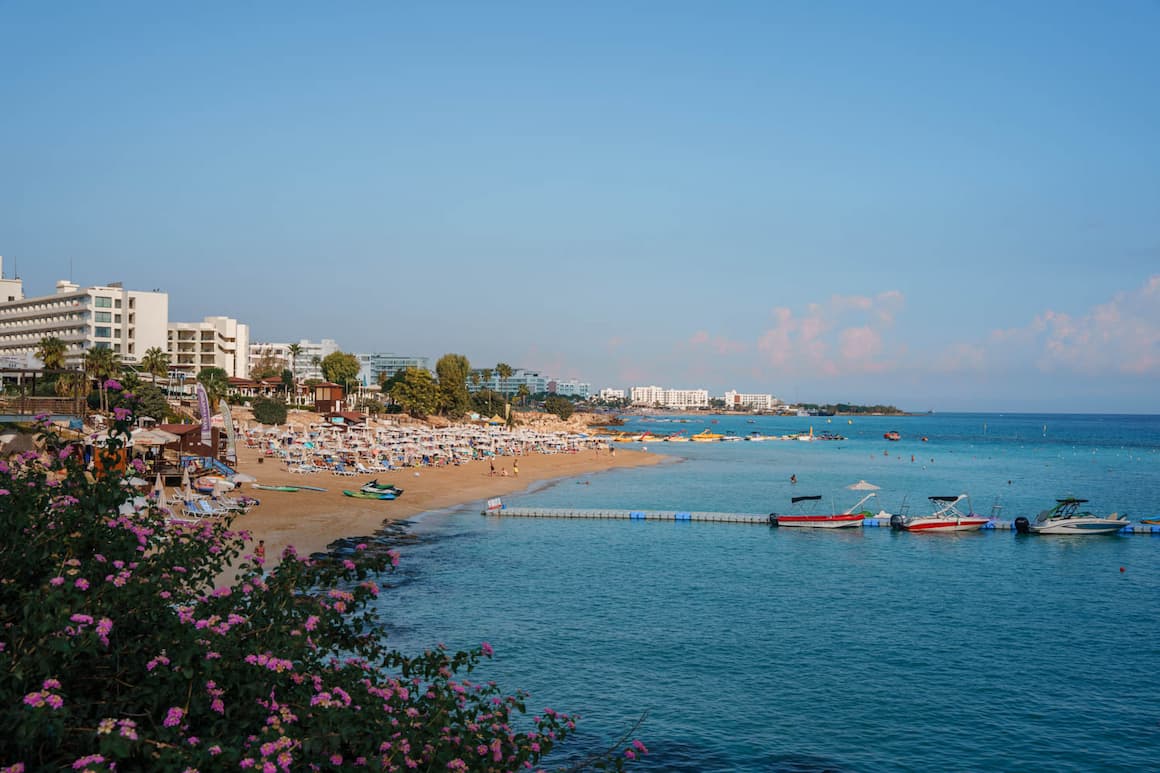
Photo: Mal Hellyer
I know, I know, this kind of frenetic scene isn’t everyone’s “cup of tea.” Before you scroll past this section as fast as your middle finger can manage, there’s a lot of other stuff to see around this seaside hangout once your hangover has worn off – or at least become more of a dull throb rather than a full-on drum solo.
If you go in an easterly-ish direction, there’s a gorgeous national park area called Cape Greco. There are several places you can swim off the rocks and snorkel here, so if you don’t mind lugging around some gear alongside a big water bottle, do it.
There are several beautiful sandy beaches within stumbling distance of downtown Ayia Napa, including the famous Nissi Beach. The crowds can get wild – it’s definitely not for anybody seeking a touch of Zen – but that’s kind of the point of Ayia Napa.
Backpacking Paphos
Paphos is the place to go on Cyprus if you grew up reading Greek myths and daydreaming about kicking it old (really old) school with Aphrodite. It’s the place where the Goddess of Love supposedly emerged from the sea to set foot on land for the first time.
Greeks and then Romans made their home along this legendary slice of coastline, the remnants of their ancient habitations visible at the Paphos Archaeological Park and the Tomb of the Kings. Honestly, it’s not the most impressive collection of ruins I’ve ever seen, but the atmosphere of a lost civilization is poetically haunting.
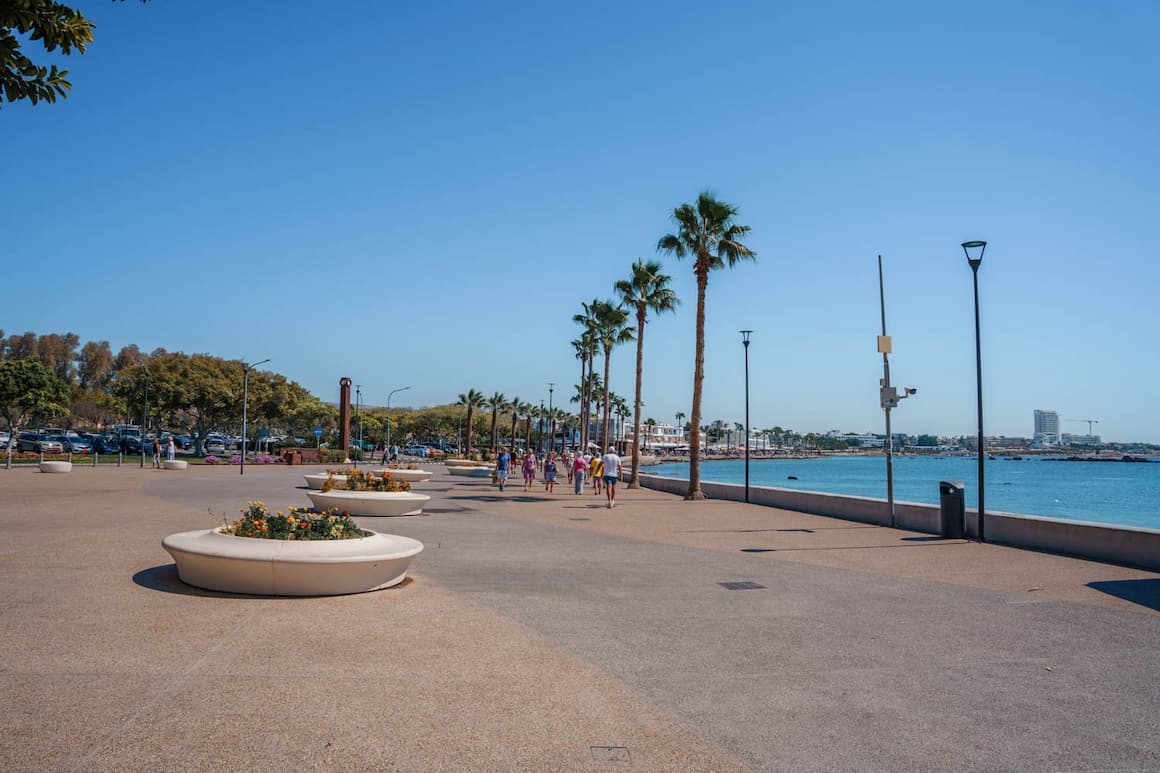
Photo: Mal Hellyer
The Old Town of Paphos isn’t exactly a looker, but there’s cheap accommodation and friendly cafes where you can grab a meal and a beer once you’re done with the sightseeing. I personally loved Sykaminia Café, which rocks the Bohemian style
Oh, one last thing while you’re here: check out the sunset at Aphrodite’s Rock. It’s about a 20-minute drive outside of Paphos, so not exactly walking distance, but there’s no better place for an end-of-day dip and some golden-hour photos.
Backpacking Larnaca
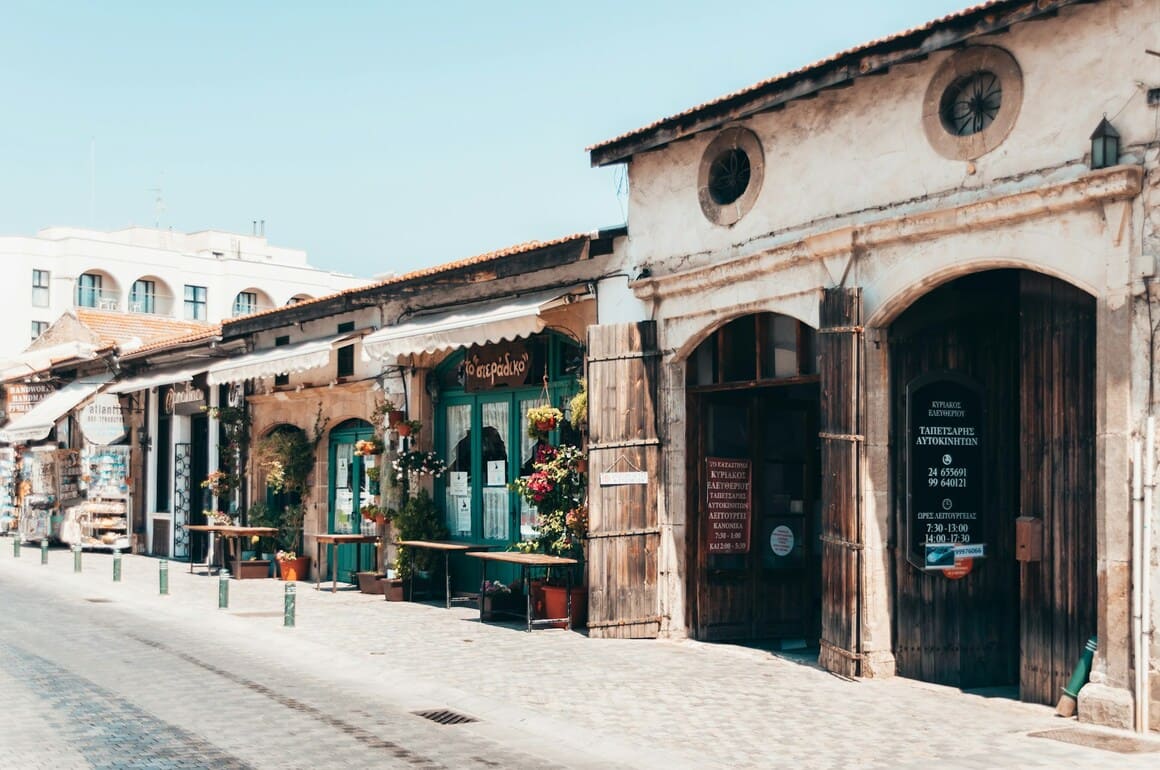
The main thing to know about Larnaca is that it’s where my airplane landed. Just Kidding. Kind of…
Larnaca is probably not going to be your highlight in Cyprus, although it is interesting from an anthropological perspective if you want to see how modern Cypriots live.
There are a handful of things to check out to pass some time before heading off to other parts of the island. There’s a promenade with an OK beach, a medieval fort, and the Holy Church of Saint Lazarus, plus plenty of places to eat and drink.
Nothing I can recall stood out much, though. Sorry, Larnaca!
Backpacking Limassol
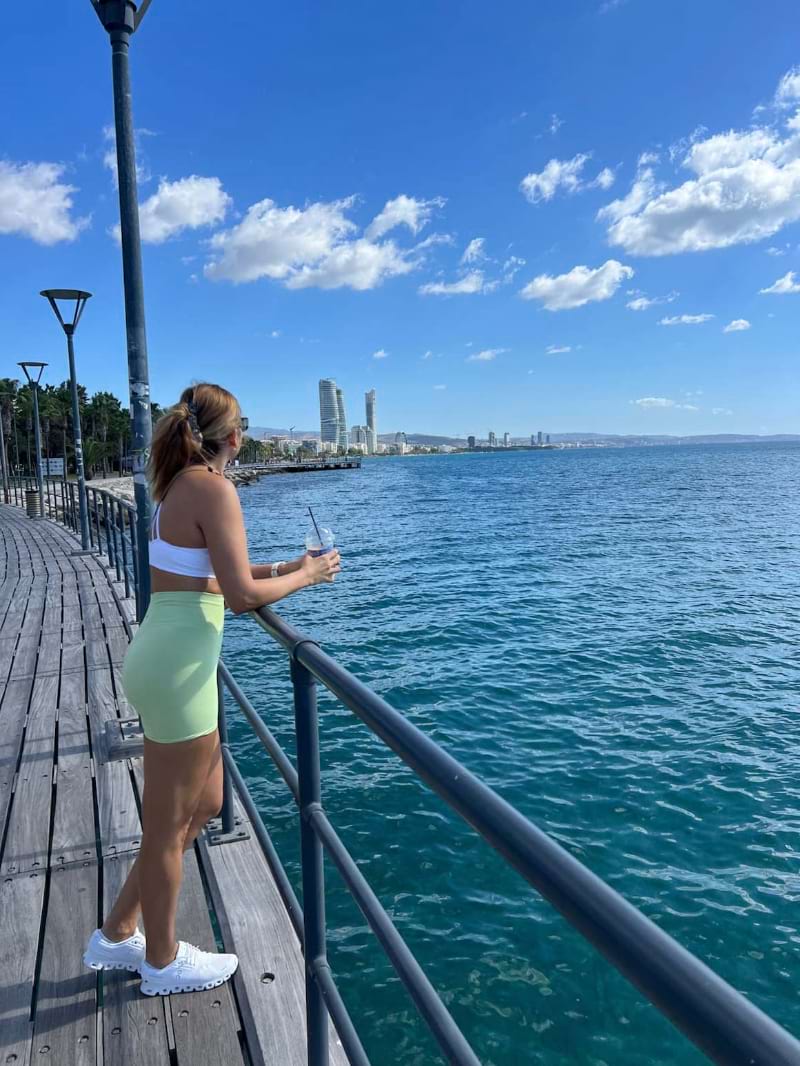
Photo: Mal Hellyer
Limassol (Lemesos to the locals) is one of the more expensive resort towns in Cyprus. There is a nice enough old bit with a medieval castle at its heart, but mostly, Limassol is geared towards business wheeling and dealing.
There are noticeably more skyscrapers here than anywhere else on the island, complemented by la-di-da restaurants and a buzzy nightlife. There’s also a super bougie marina lined with yachts that probably cost millions of dollars and are maybe owned by nefarious Russian oligarchs.
Limassol was built between two ancient towns, Amathus and Kourion, which you can reach by bus. A bit like the ruins around Paphos, these don’t feature on my mental list of the best ancient Greek ruins I’ve ever seen, but if old buildings are your jam, have at it!
I suppose what I appreciate most about Limassol is that it’s a good location to base yourself to see the whole of Cyprus since it’s more central than the other major cities.
Backpacking Nicosia
There are a couple of wild facts about Cyprus that caught my attention before I even set foot on the island. One is that it has the only divided capital in the world, Nicosia. Half of the city is in the hands of the Greek-influenced Republic of Cyprus, while the other side is controlled by Turkey-backed Northern Cyprus.
Like the rest of the country, the capital has been split between the two different factions since 1974.
From a backpacker’s perspective, the Greek side of Nicosia is a bit blah. There are a few attractive streets around the old town center, the famous Famagusta Gate left over from the Venetians, and a handful of pretty churches like Panayias Phaneromenis and the Archangel Michael Trypiotis, but it’s mostly a modern, unremarkable place.
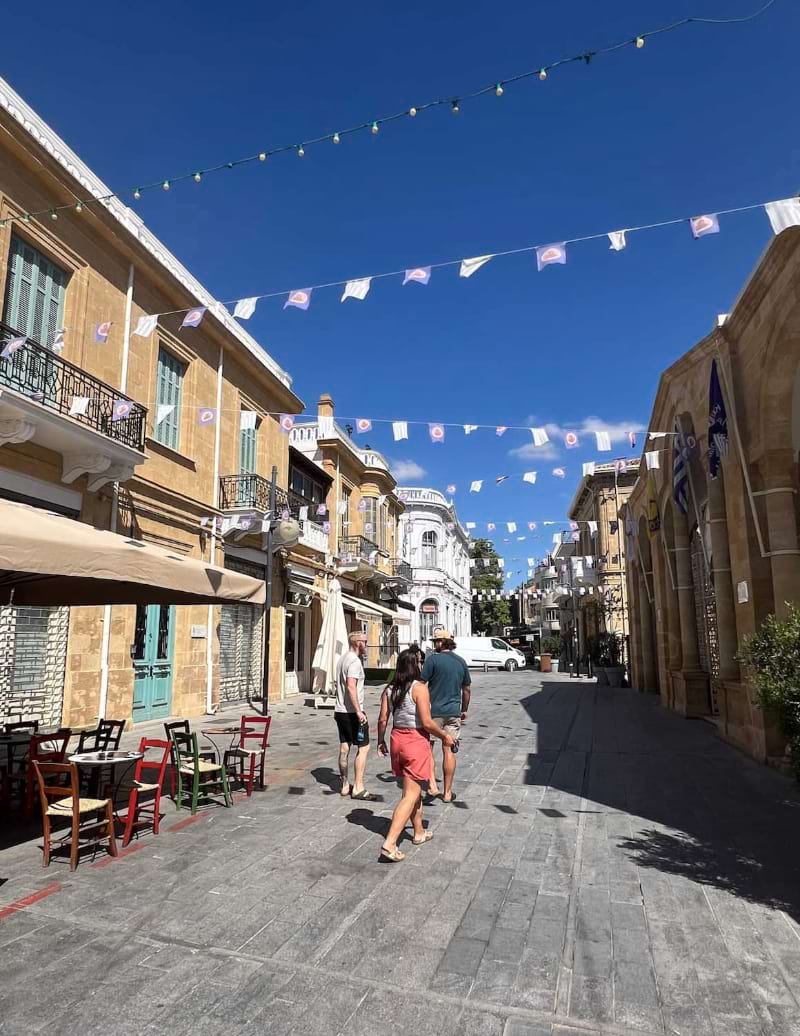
Photo: Mal Hellyer
In my opinion, the Turkish side of Nicosia is where it’s at. More traditional and charming, it also has cheaper restaurants and souvenirs. Score one for the wallet!
All you need to cross the so-called Green Line that acts as a buffer between Nicosia’s two halves is your passport. The main checkpoint is easy to find, right on the city’s main thoroughfare, Ledra Street.
Once you’re on the Turkish side, a focal point for restaurants and shops is the 15th-century Büyük Han. There used to be loads of these “han” buildings scattered throughout the Ottoman Empire that functioned as inns for travelers and merchants, but this is a particularly well-preserved one.
A short walk away is what I would say is the most impressive church in Cyprus, Selimiye Camii, a gothic beast of a building that’s been converted into a mosque.
The whole area around this part of Nicosia is dotted with street-side tables where you can plonk yourself down and enjoy a Turkish coffee with some kadayif or baklava.
FYI, the currency here is the Turkish lira, though most places will accept the euro (scroll ahead to the money section for more deets).
Backpacking Northern Cyprus
Everything in Northern Cyprus is less developed, less expensive, and less well-traveled. Kind of makes it sound more attractive, right?
I love the area around Girne (Kyrenia to the Greeks), up on the north of Northern Cyprus. There are a couple of atmospheric medieval castles – St. Hilarion especially, is wildly beautiful – as well as a charmingly old-school harbor.
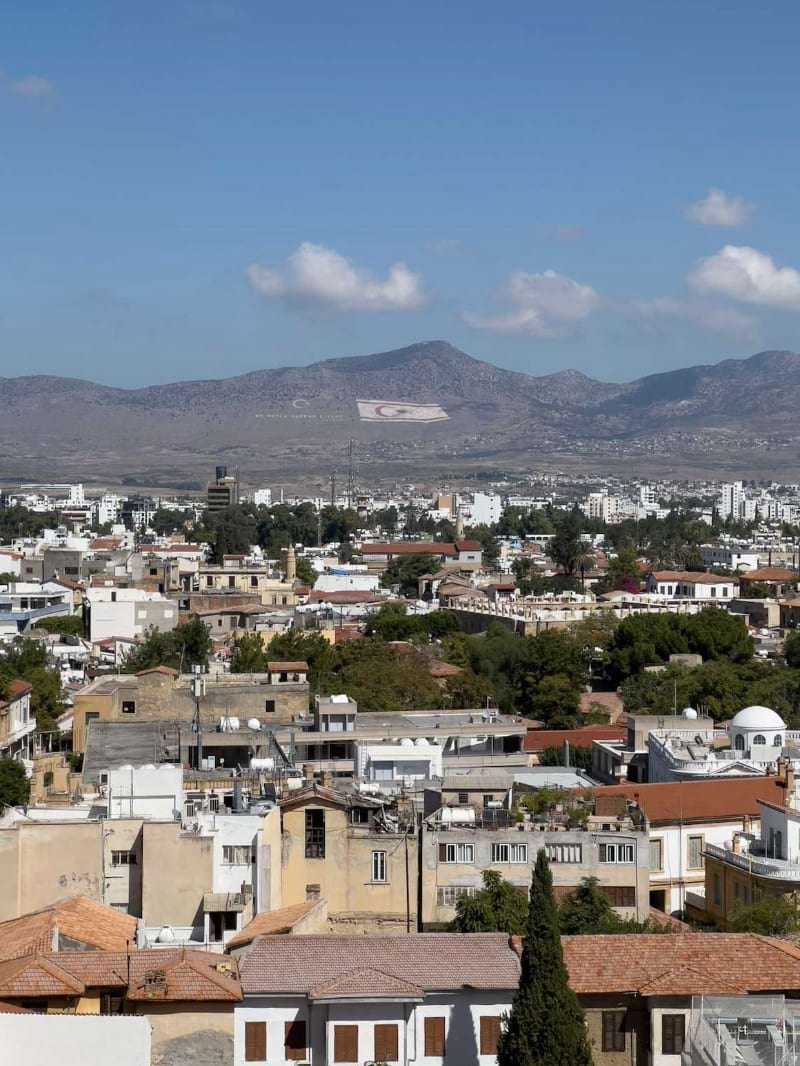
Photo: Mal Hellyer
Out east, I like to think of Gazimagusa (aka Famagusta) as the city of ruins. On the one hand, you’ve got the medieval-era Venetian citadels and churches, and on the other, the modern ghost town of Varosha, abandoned to the elements during the Cypriot civil war.
To the north of Gazimagusa, there’s the sprawling archeological site of ancient Salamis. It was left to its own devices more than a millennium ago, but somehow, there are still some buildings amidst the rubble.
Backpacking the Troodos Mountains
The Troodos Mountains are where you can have a real adventure in Cyprus. Away from the beaches and resort towns, it’s a slower, chiller pace of life.
There are a ton of banging places to hike in this part of the country. If you’re in a kind of mellow mood and want an intro-level option, the route from Pano Platres out to the Milomeris Waterfall takes about 40 minutes, finishing with a dip in a natural pool.
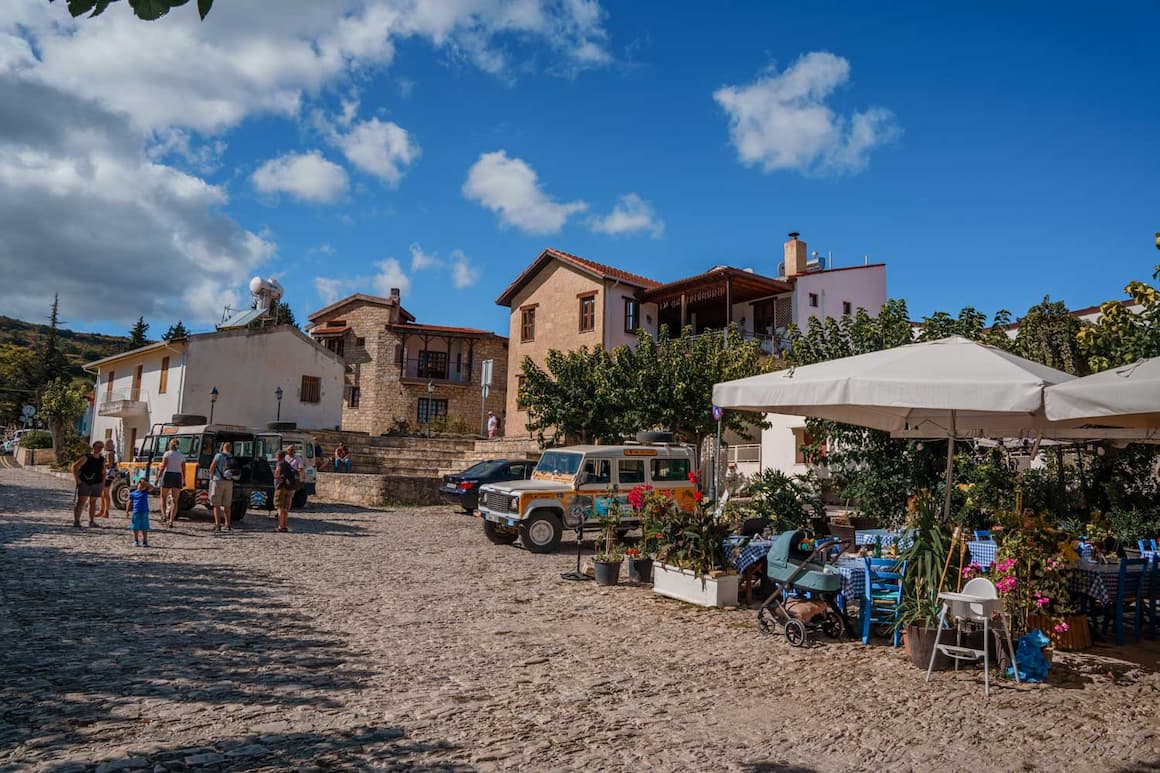
Photo: Mal Hellyer
I also went on a couple of longer hikes along the Madari Circular Trail (about 4 hours) and the Atalanta Nature Trail (about 5 hours). Both are a bit more challenging, but it’s not so hardcore that you’re going to find yourself going bum first down the screen.
Cute little villages are scattered all over the hills, though most of the time, it’s only possible to walk between them along the country roads. I fell in love with the village of Lofou, a place of cobbled streets and stone houses with amazing views over the surrounding countryside. It also has its own microbrewery – genius entrepreneurship- and the beers weren’t bad either!
Some of the Troodos villages are definitely more set up for tourism. Omodos was the worst culprit of this that I visited, though it was still pretty and had an attractive monastery – by the by, quite a few random monasteries spread over the hills, worth popping in for a peek.
Other Troodos villages are little more than a street of houses with nothing to do but stare out on unblemished nature.
Getting Off the Beaten Path in Cyprus
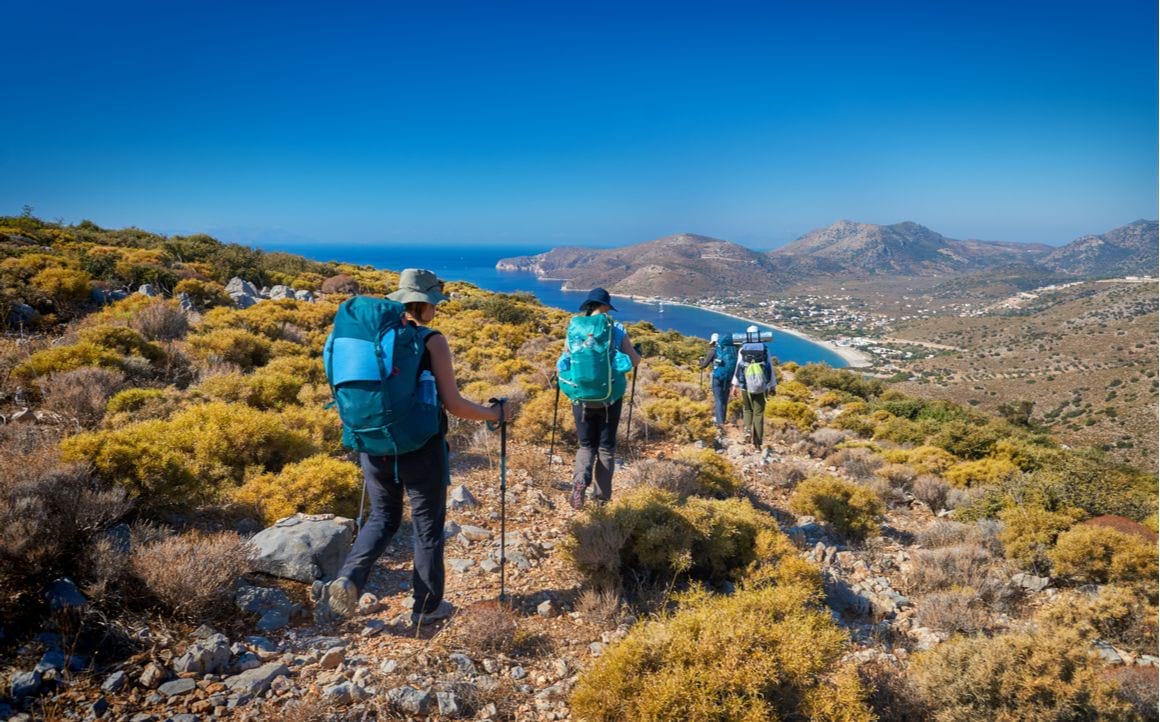
There are pockets all over Cyprus that people don’t tend to visit as much, partly because they’re hard to access and partly because they just haven’t been as developed for tourists.
I’ve already banged on quite a bit about the random villages and assorted hiking paths you can find in the Troodos Mountains, but there are also loads of little coves around the coast (especially west and north) that are slightly more challenging to reach and so don’t get much foot traffic.
Northern Cyprus is also a bit of an untouched marvel. Outside Nicosia, Girne, and Gazima?usa, it’s almost all the road less traveled here. For the most adventurous, the Karpas Peninsula is a largely unmined gem.
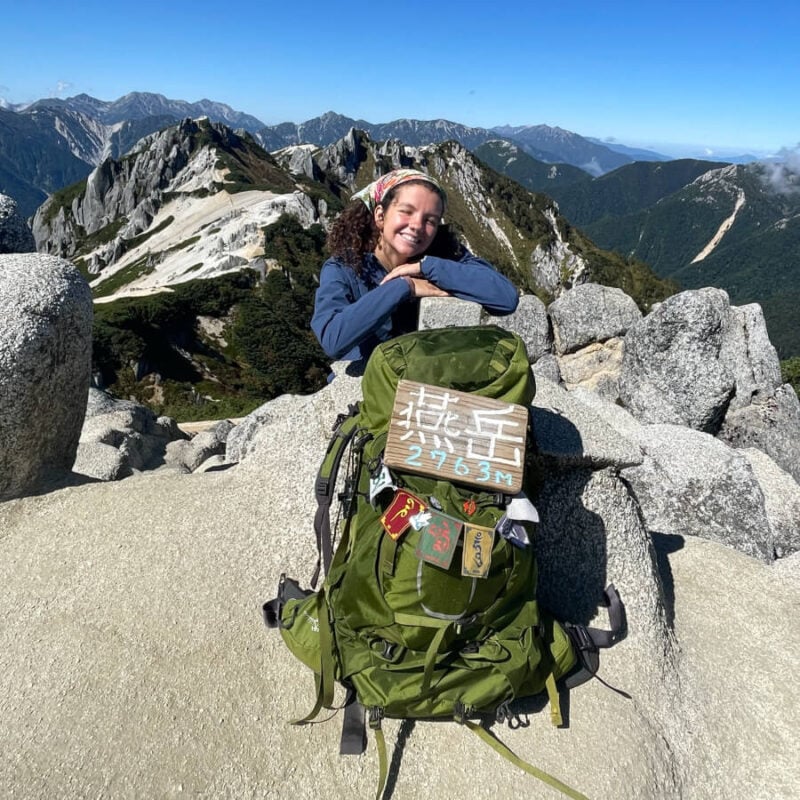
We’ve tested countless backpacks over the years, but there’s one that has always been the best and remains the best buy for adventurers: the broke backpacker-approved Osprey Aether and Ariel series.
Want more deetz on why these packs are so damn perfect? Then read our comprehensive review for the inside scoop!
View on Osprey8 Top Things to Do in Cyprus
Man, this is such a subjective list of top things to do in Cyprus, but hey, I’m writing this post, and these are my fondest memories, all right?
1. Go Wine Tasting!
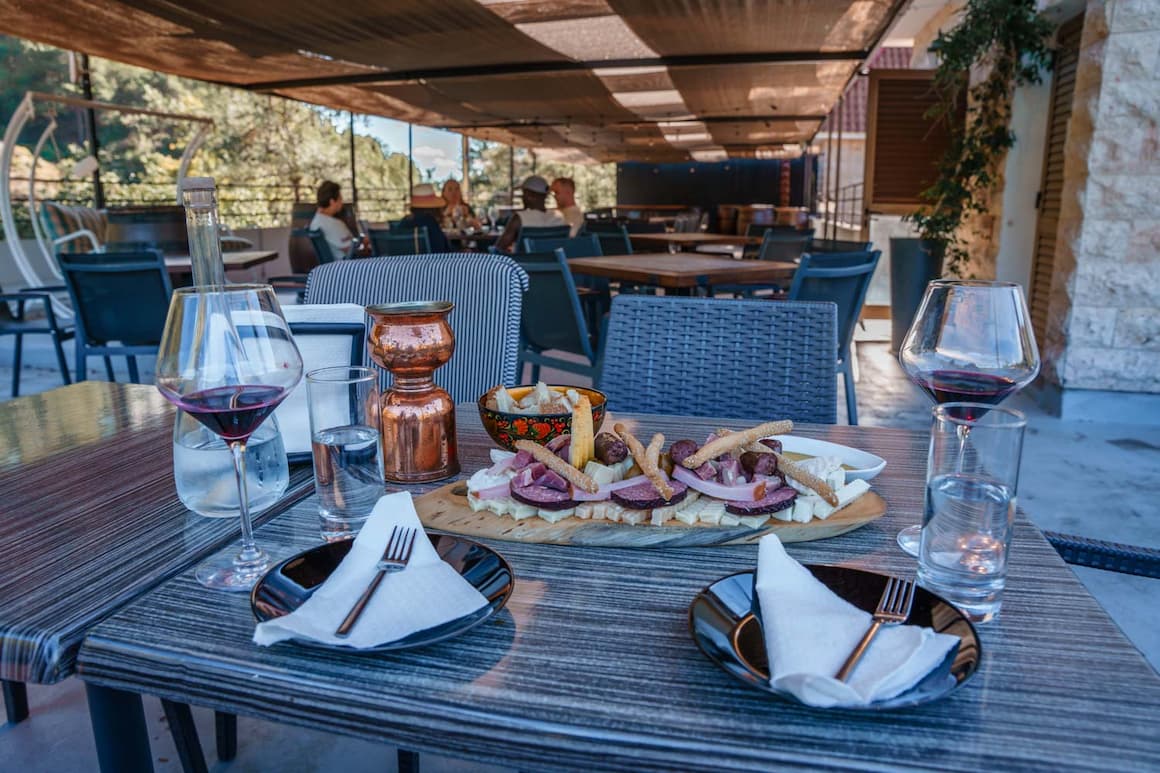
Photo: Mal Hellyer
Particularly on the western slopes of the Troodos Mountains, there are lots of little wineries doing their thing. Most of it is very small-scale, family-run stuff, which is cool – plus, I was intrigued by the native grapes like Maratheftiko and Xynisteri that I haven’t seen anywhere else in the world.
2. Join a Blue Lagoon Cruise
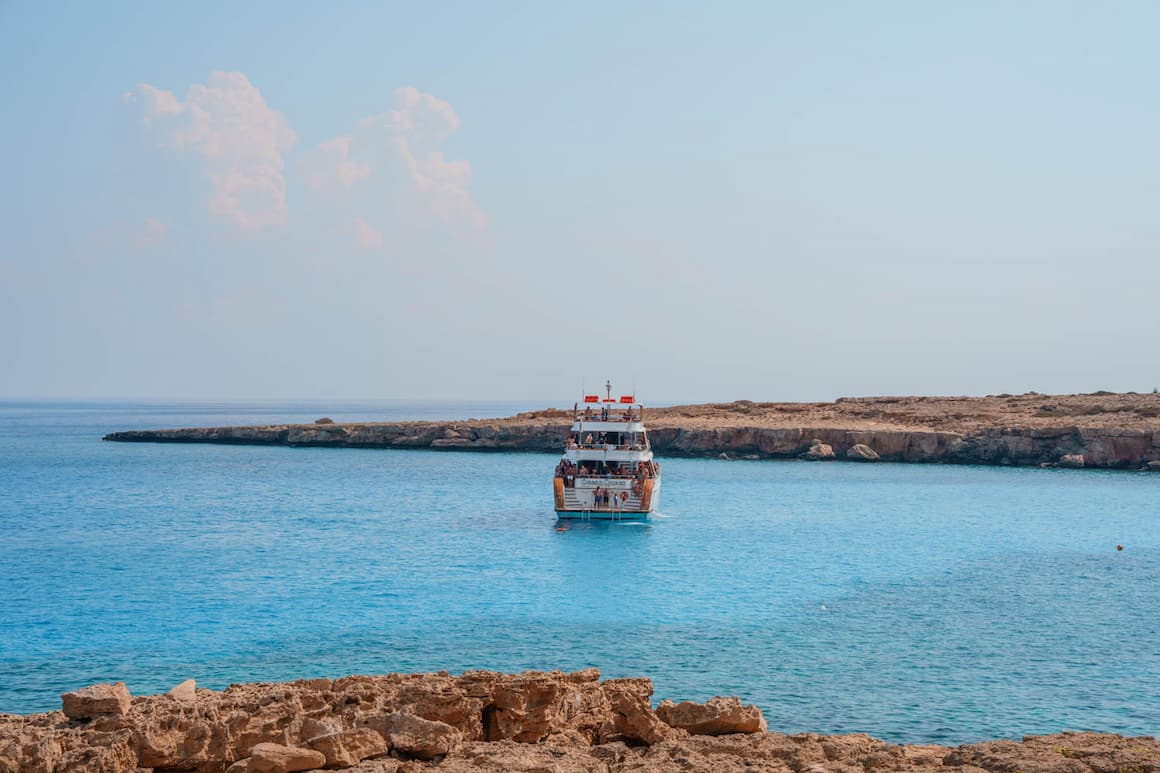
There are a bunch of different boats that take people out on the sea surrounding Cyprus. From the deck, you can leap into the waters and enjoy swimming with the local wildlife. The one I went for cost around $25 per person, which seemed like a decent price. The boat was a bit crowded, but it was with a fun, sociable crew, so it was a win-win.
3. Hike Avakas Gorge

Avakas Gorge is one of the most famous hikes in Cyprus – and one of the more challenging. Prepare to scrabble over rocks and through water pools. It took me about 4 hours, but I spent quite a bit of time trying to lure the local goats over, so I’m sure it’s possible to complete the trail there and back in 3 hours.
4. Turtle Spotting At Green Bay
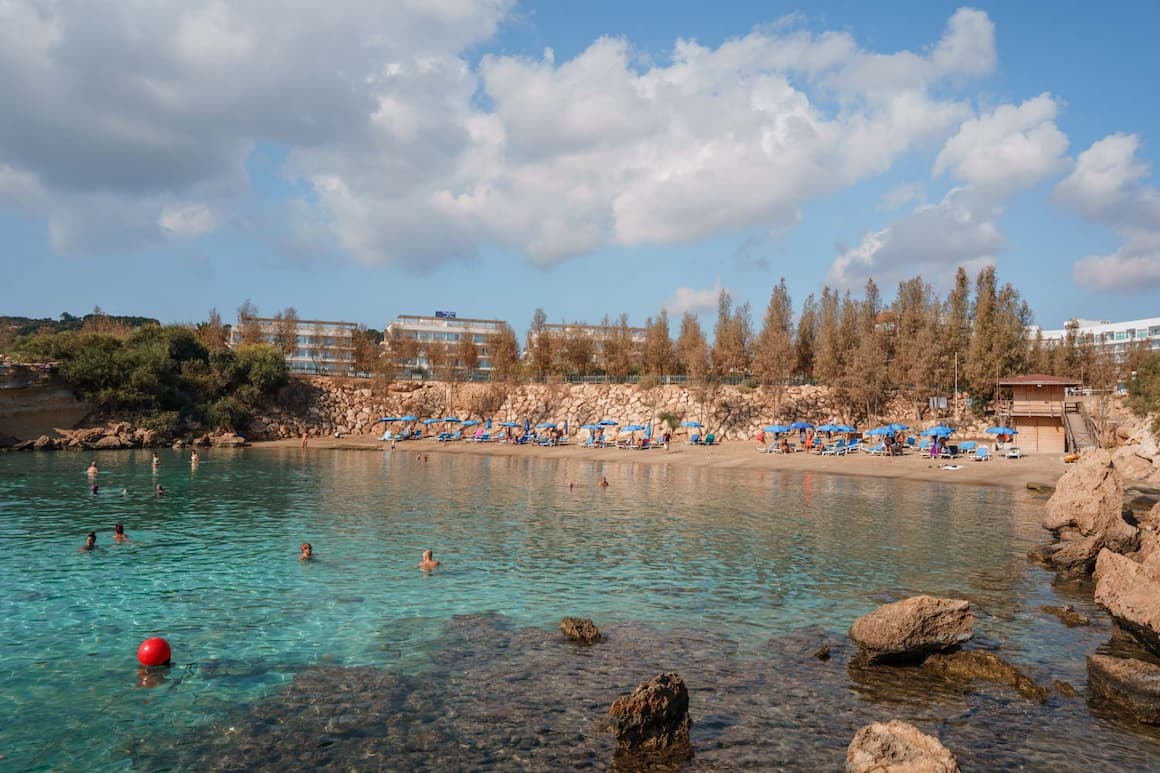
Photo: Mal Hellyer
A bit to the north of Cape Greco, there’s a place called Green Bay that is famous for being a gathering place for turtles in the early mornings. According to locals, they sort of just hang out on the sea floor, basking on the sandy bottom. I didn’t get to see any, which was a bummer, but I still had a good time snorkeling about the cove, which is home to other marine life and random underwater stone columns and statues.
5. Tour The Paphos Archaeological Site
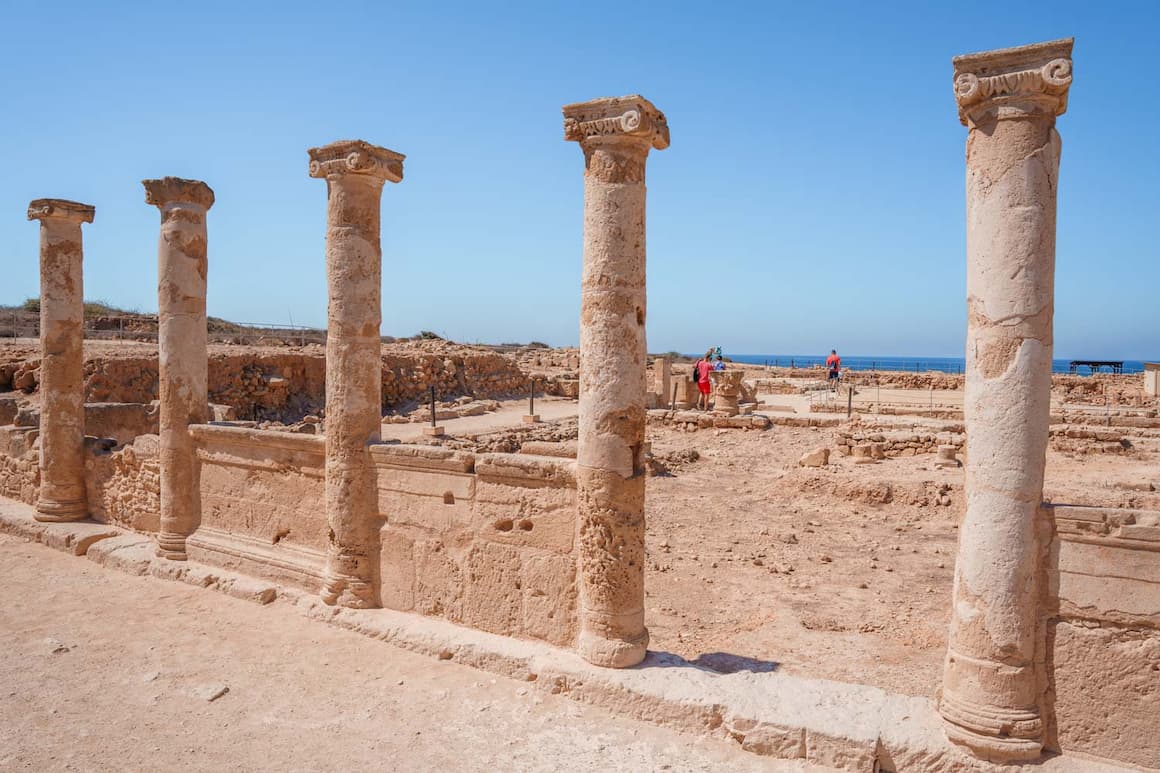
Remnants of Ancient Greece and Rome are scattered over the sizable Paphos Archaeological Site – and they’re still excavating more all the time. The impressive collection of 2,000-year-old mosaics showing things like buff men hunting wild beasts and bare-breasted women frolicking in wooded groves have even nabbed the place a UNESCO World Heritage Site plaque.
6. Go Out In Ayia Napa
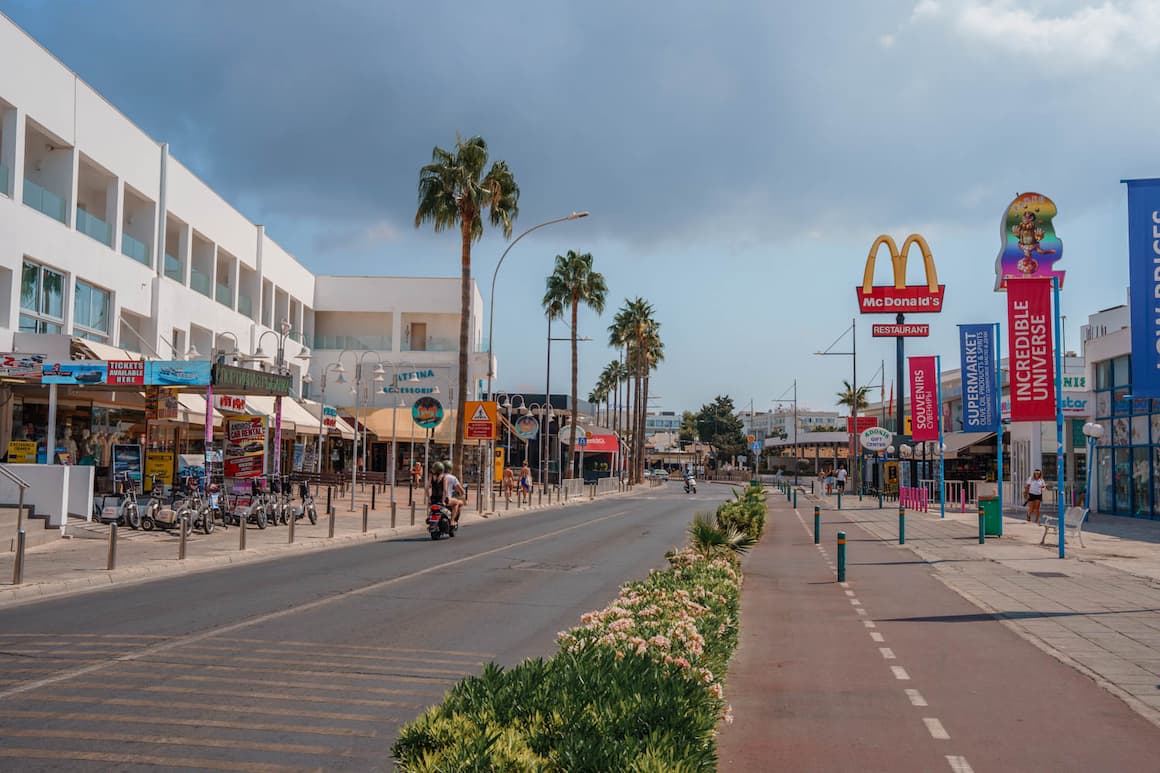
Photo: Mal Hellyer
The party capital of Cyprus is a must for anybody who enjoys a drink and a dance among free-spirited holidayers looking to shrug off their cares – and often their clothes. Most of the action takes place within the few square blocks around the main town square, so you don’t have far to stumble on a bar-hopping night out.
7. Go Kayaking At Nissi Beach
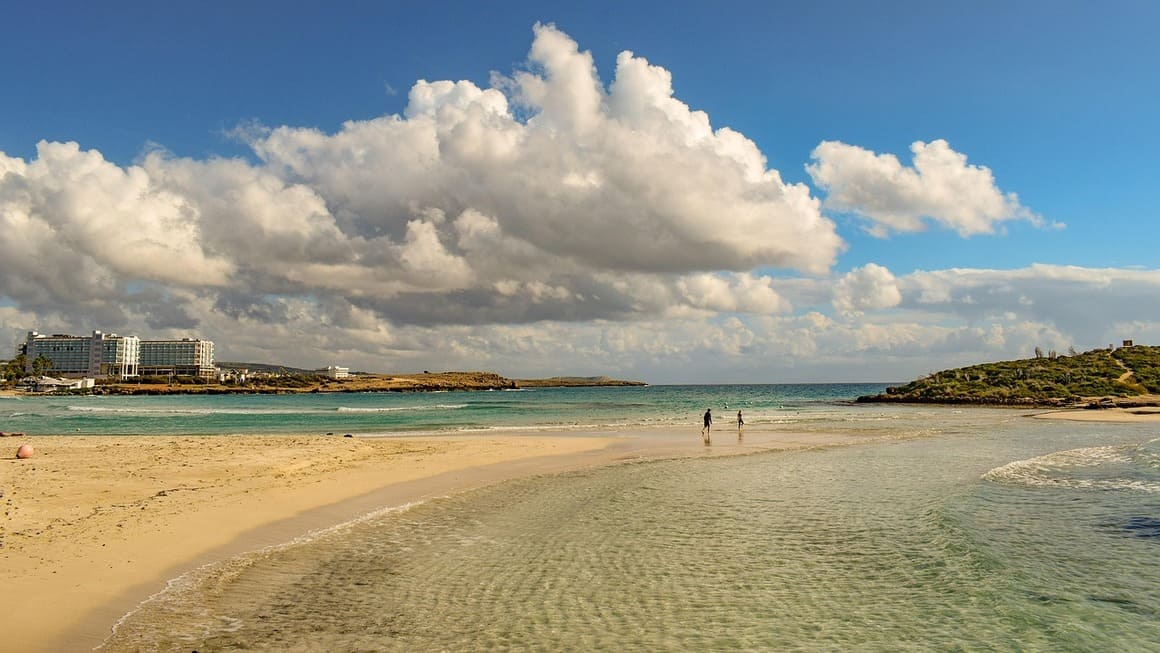
The coast around Ayia Napa is stunning, but it can get quite crowded during the high season.
My solution? Rent a kayak and paddle out to sea, where you can enjoy the natural beauty of the area without the hordes of sun worshippers. A company called Nissi Watersports rents kayaks for €15 per hour and paddleboards for €20 per hour.
8. Gorge On Turkish Food In Nicosia
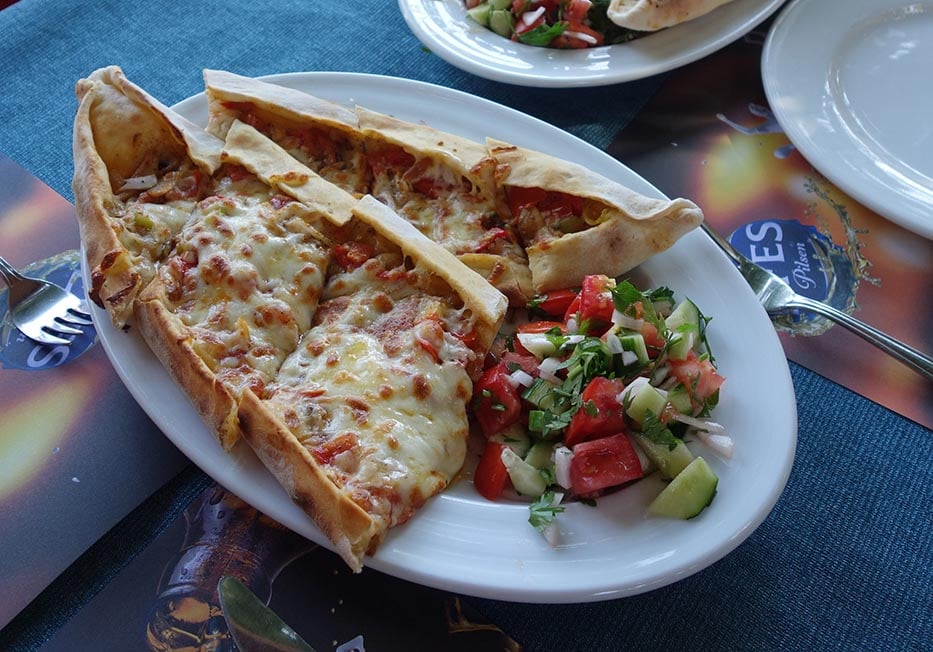
Image: Nic Hilditch-Short
The Turkish side of Nicosia is foodie heaven, especially if you like your meat. Platters heaped with kofte and kebabs, crispy flatbreads topped with minced meat (lahmacun), fluffy canoe-shaped pizzas (pide) topped with cheese, grilled vegetables, and golden egg yolk – I could go on, but I’m salivating buckets over here, and I haven’t even got to the amazing sweet pastries.
The restaurants in the Büyük Han building offer a bit more ambience but the price is jacked up accordingly. I found you can get much cheaper versions of the same foods from stalls in the surrounding streets. I’m talking 150-400 Turkish lira (about $4-11 US) for a filling meal.

Wanna know how to pack like a pro? Well for a start you need the right gear….
These are packing cubes for the globetrotters and compression sacks for the real adventurers – these babies are a traveller’s best kept secret. They organise yo’ packing and minimise volume too so you can pack MORE.
Or, y’know… you can stick to just chucking it all in your backpack…
Get Yours Here Read Our ReviewBackpacker Accommodation in Cyprus
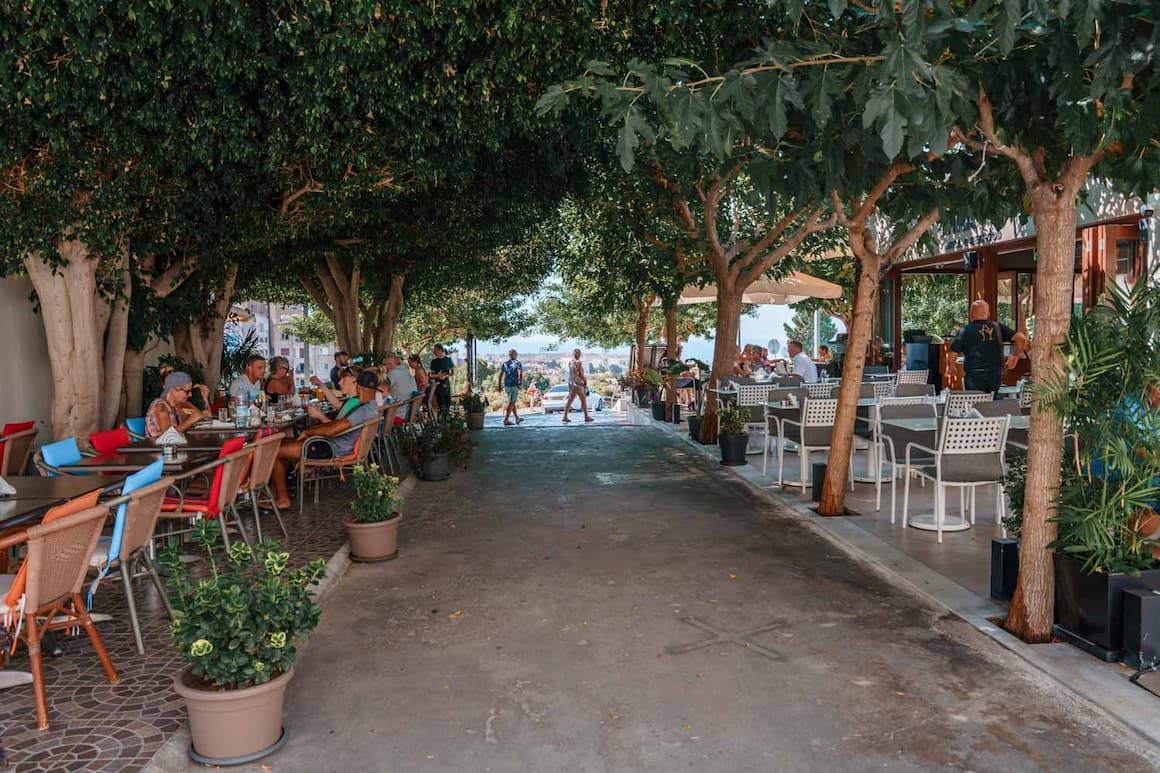
Photo: Mal Hellyer
Cyprus is not a hotbed of hostels, so I’d cast my net wider and also look at renting a room in someone’s flat. If you get a deal for $40-50 a night, that’s about as good as it gets, though it is possible to find the very occasional dirt-cheap places to stay in Cyprus for $20.
Another alternative is to go to a campsite. This is quite a bit less (around $5-8 per person per night), and some places will also rent the gear to you for a little bit more.
The Best Places to Stay In Cyprus
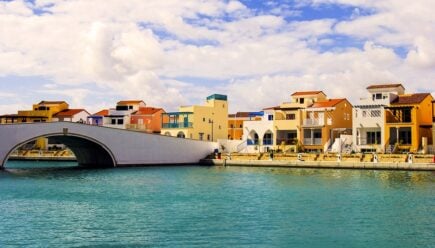
Limassol
Limassol is the second-largest city in Cyprus – and due to its coastal location is the most popular destination for visitors to the island nation! The city perfectly encapsulates everything Cyprus is known for – with plenty of sandy beaches, laid back restaurants and vibrant bars on offer.
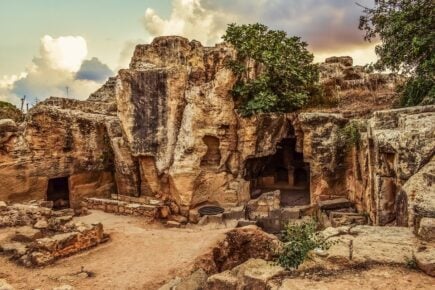
Paphos
Known as the birthplace of Aphrodite, staying in the Paphos area is perfect for visitors interested in historic attractions. There are plenty of interesting archaeological sites in Paphos, including the Temple of Apollo and the Odeon. Tala Village is also a great spot for those wanting to discover authentic Cypriot traditions.
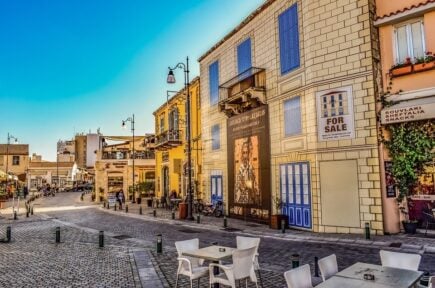
Larnaca
Larnaca is an excellent destination for foodies! It can be a bit pricier here, but if you want to sample the best Cypriot Meze in the world, you’re sure to find what you’re looking for in Larnaca.
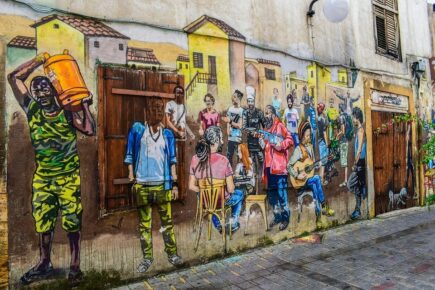
Nicosia
Nicosia is left off most itineraries to Cyprus, but it is a truly fascinating city that is a must-see for anyone interested in modern Cypriot history, culture and cuisine! Nicosia is a fantastic place to travel to and experience Cyprus’s divided political history with heaps of unique attractions around.
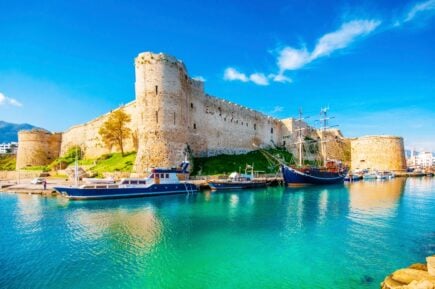
Kyrenia
As it is in Northern Cyprus on the Turkish side, Kyrenia is a great city to discover Turkish Cypriot culture. In many ways, it feels like a world apart from the more popular cities in the South. It is also the only city on the island with ferry links for onwards travel to Turkey.
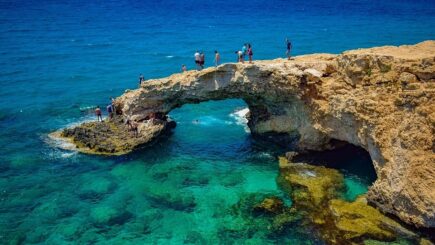
Ayia Napa
Ayia Napa is the most visited resort in Cyprus! In particular, it is renowned across Europe for its bustling nightlife. The Square is home to the biggest nightclubs in Cyprus, offering DJ sets and affordable drinks throughout the week. The beach is also home to parties throughout the year – though the most popular is during the summer.
Cyprus Backpacking Costs
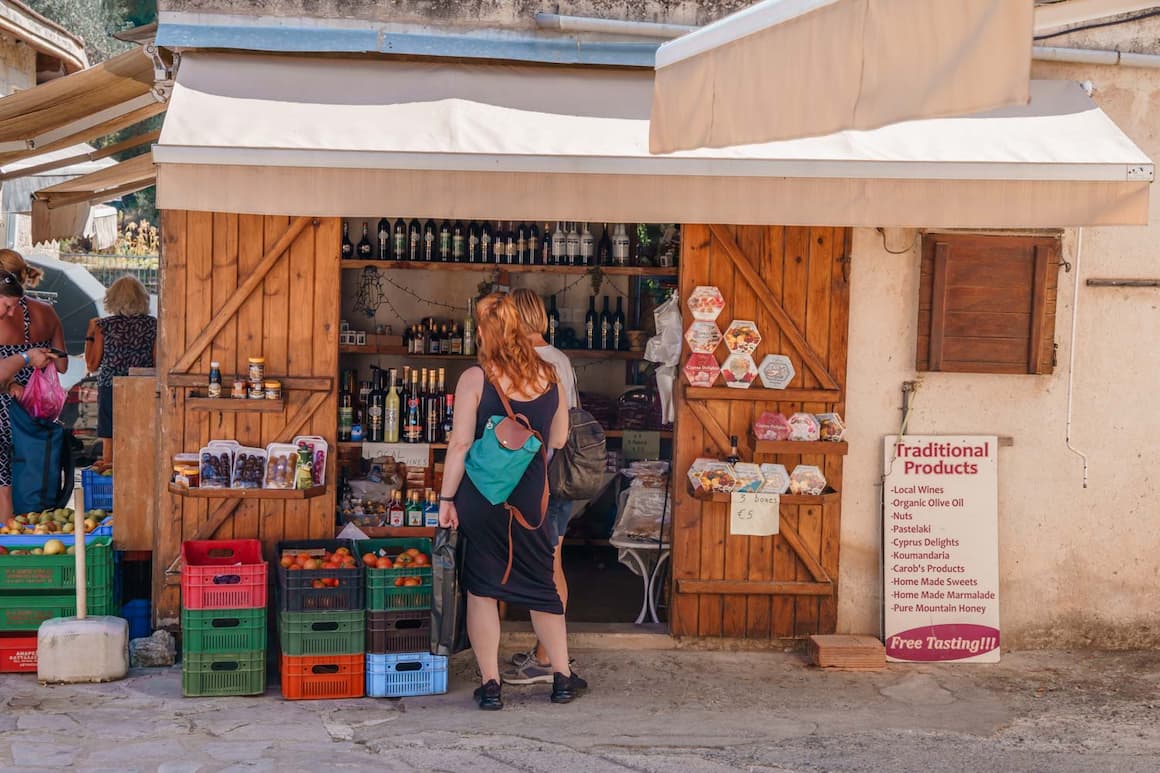
Photo: Mal Hellyer
Accommodation is easily the biggest expense in Cyprus, but eating out isn’t particularly cheap either – although you can get a bargain kebab from a hole-in-the-wall spot in the bigger cities like Larnaca and Paphos.
Activities, on the other hand, are reasonable. Beaching and hiking in Cyprus are two of the best things to do, and they’re free! Plus, entrance to museums and archaeological sites is usually low – I think I paid €2.50-€4.50 for entry to most places.
Local buses are about €1.80-€2.50, but inter-city buses range from €10-€20.
A Daily Budget in Cyprus
| Expense | Broke-Ass Backpacker | Frugal Traveller | Creature of Comfort |
|---|---|---|---|
| Accommodation | $5-$20 | $40-$50 | $60+ |
| Transport | $2-$3 | $11-$17 | $20+ (car rental) |
| Food | $5-$10 | $15-$20 | $25+ |
| Nightlife Delights | $5-$10 | $10-$20 | $20+ |
| Activities | $0-$5 | $11-$17 | $25+ |
| Total per day: | $17-$48 | $87-$124 | $150+ |
Money in Cyprus
The Greek side of Cyprus has used the euro since 2008, which is super handy for any travelers doing a trek around Europe. Cards are also widely accepted, thanks to the country’s well-developed tourism economy.
If you cross the border into Northern Cyprus, try to pay for things in Turkish lira. Yeah, it’s a pain in the bum to do the whole money-changing thing, I know, but the reward is you’ll get better bang for your buck.
Quite a few places on the Turkish side of Nicosia advertise prices in both lira and euros, which is a bit of a slap in the face if you don’t have lira since you can clearly see that you’re getting a bad deal when paying in euros.
Tips for Travelling to Cyprus on a Budget
There are a couple of evergreen money-saving options that you can use to keep the costs down, as well as a few that are 100 emoji for Cyprus pros.
- Visit off-season. Winter is a gazillion times cheaper than summer. Sure, some stuff will be closed, and the temperatures don’t so much sizzle as gently smolder from November, but it’s still warmer than most of Europe. It’s an ideal place to visit in Europe in winter.
- Camp. The Cyprus authorities frown upon wild camping, but I met a few people who had gotten away with it. If you’re not a risk-taker, there are also several campsites that charge reasonable fees.
- Couch surf. Always an option for the dedicated backpacker, you can’t beat a night on a friendly local’s couch. Plus, it’s a good way to get some recommendations!
- Hitchhike. Thumbing down rides isn’t something people do much in Cyprus, but up in the Troodos Mountains or out on rural roads, hitchhiking is worth a go.
- Tap water is drinkable. Why spend money on bottled water when you can drink from the faucet for free? Nuff said.
- Eat gyros. Delicious, filling, and cheap, this is the go-to meal if you want to save money on grub. You can usually get it with either chicken, pork, or lamb, depending on the place, so it’s not as if you’re getting the same meal each time.
Best Time to Travel to Cyprus
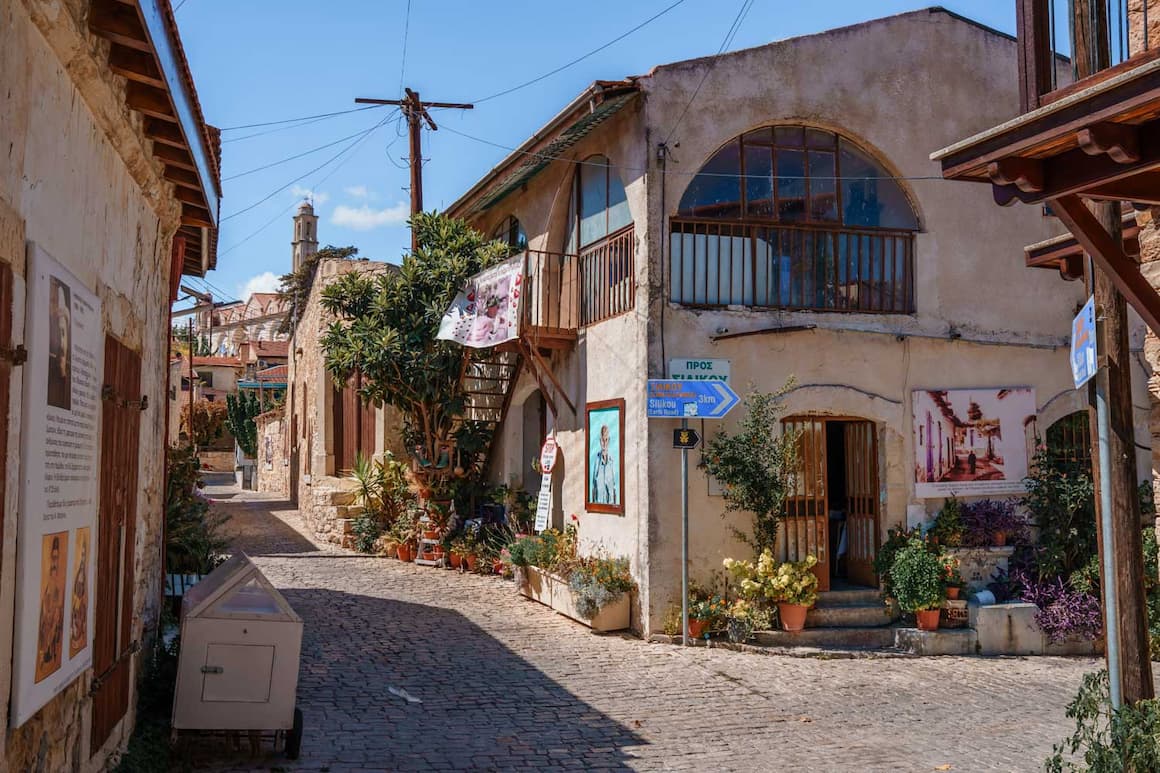
Photo: Mal Hellyer
Look, summer is banging. From June to August, you get amazing weather, and the party is in full swing.
It’s also the worst time to travel on a budget. Everything is priced up to take advantage of the influx of tourists, who pack into the beaches till it’s one big sea of white and red flesh.
The cheapest time is winter, and to be honest, the weather is still pretty good. The downside is some staff closes, since the locals need holidays too and they might as well relax during the slowdown.
Personally, I’d go during the shoulder seasons, which are April to May and September to October. You won’t get the absolute best, rock-bottom prices, but you’ll still make some savings – and the extra cost will be more than balanced out by better weather to see Cyprus at its finest.
What to Pack for Cyprus
I know I’m not your mum, so I’m not going to bang on about packing, but I do want you to have a good time, dearie. So here are my 6 travel essentials for Cyprus:
Ear Plugs
Snoring dorm-mates can ruin your nights rest and seriously damage the hostel experience. This is why I always travel with a pack of decent ear plugs.
Hanging Laundry Bag
Trust us, this is an absolute game changer. Super compact, a hanging mesh laundry bag stops your dirty clothes from stinking, you don’t know how much you need one of these… so just get it, thank us later.
Sea To Summit Micro Towel
Hostel towels are scummy and take forever to dry. Microfibre towels dry quickly, are compact, lightweight, and can be used as a blanket or yoga mat if need be.
Monopoly Deal
Forget about Poker! Monopoly Deal is the single best travel card game that we have ever played. Works with 2-5 players and guarantees happy days.
Grayl Geopress Water Bottle
Always travel with a water bottle! They save you money and reduce your plastic footprint on our planet. The Grayl Geopress acts as a purifier AND temperature regulator. Boom!
Staying Safe in Cyprus
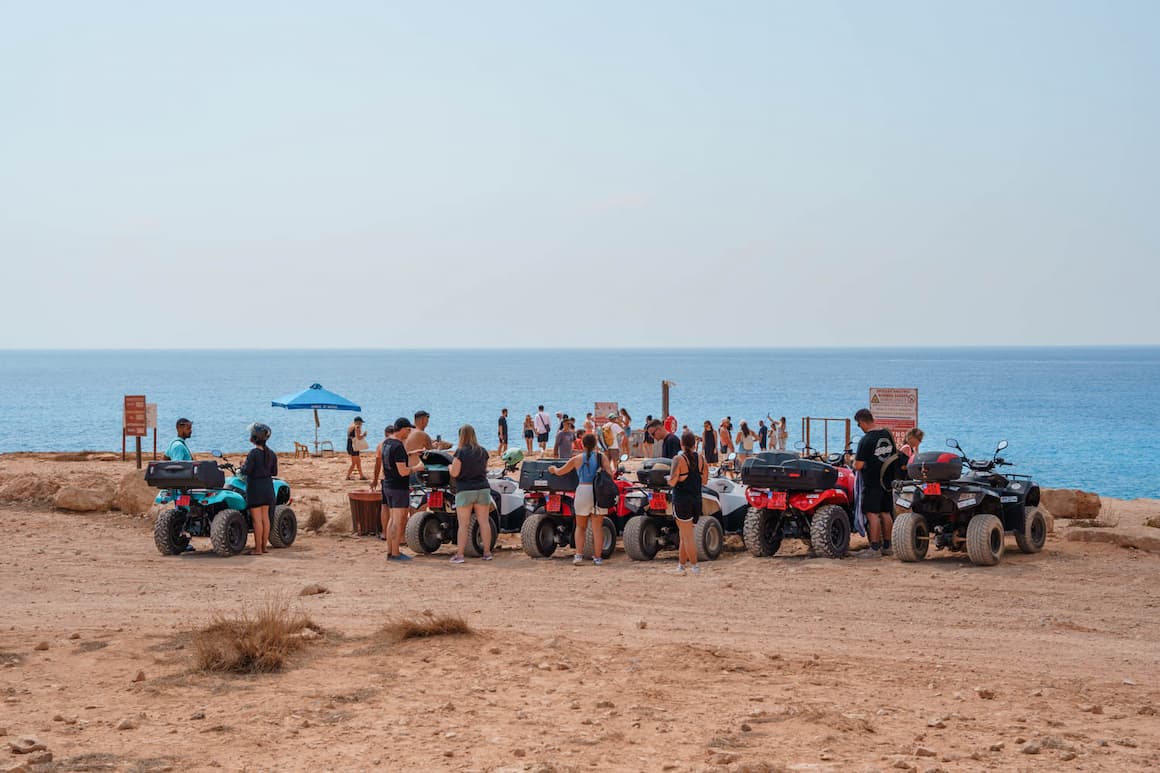
Photo: Mal Hellyer
I’m pretty much Bob Marley when it comes to my attitude about safety in Cyprus: don’t worry about a thing. There are risks like pickpocketing and drink spiking that you need to be aware of pretty much anywhere in the world, but otherwise, you’re golden.
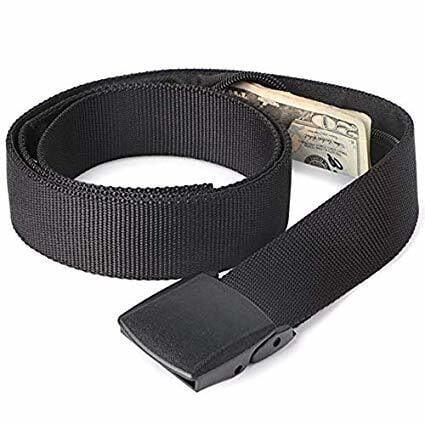
Stash your cash safely with this money belt. It will keep your valuables safely concealed, no matter where you go.
It looks exactly like a normal belt except for a SECRET interior pocket perfectly designed to hide a wad of cash, a passport photocopy or anything else you may wish to hide. Never get caught with your pants down again! (Unless you want to…)
Hide Yo’ Money!Sex, Drugs, and Rock ‘n’ Roll in Cyprus
Officially, there’s a zero-tolerance policy for all kinds of drug use, and prison sentences can be handed out for people who are caught in possession. That doesn’t seem to have had much of an effect on the use of cannabis, though…
As for sex, to each their own! The island is a pretty sex-positive place – in fact, it’s a big part of the scene in lots of the resort-y beach areas.
Getting Insured BEFORE Visiting Cyprus
Nobody wants bad things to happen on holiday, but guess what, sometimes they do. I’m all about that chill, take-it-as-it-comes vibe, but I also don’t want to get boned by crazy bills if I have an accident.
Grab yo’ self some good travel insurance before heading to Cyprus.
ALWAYS sort out your backpacker insurance before your trip. There’s plenty to choose from in that department, but a good place to start is Safety Wing.
They offer month-to-month payments, no lock-in contracts, and require absolutely no itineraries: that’s the exact kind of insurance long-term travellers and digital nomads need.
SafetyWing is cheap, easy, and admin-free: just sign up lickety-split so you can get back to it!
Click the button below to learn more about SafetyWing’s setup or read our insider review for the full tasty scoop.
How to Get Into Cyprus
Larnaca and Paphos are the main airports, though you can also fly into Northern Cyprus via Ercan, just outside Nicosia. There are direct flights from all over Europe, with plenty of budget airlines to choose from.
Entry Requirements for Cyprus
Europeans, Americans, Canadians, Malaysians, Nicaraguans – all these nationalities are among the 60 that don’t need a visa to visit Cyprus for up to 90 days. Just make sure your passport has at least 6 months left on it.
How to Get Around Cyprus

Photo: Mal Hellyer
The best way to get around Cyprus is by renting a car, but that will set you back at least $120 for a week. I saw plenty of people zooming about on quad bikes, particularly to get to out-of-the-way beaches, but I balked when I heard they were costing more than $100 per day.
Another option is to rent a bike, which you can get for €20 per day AND a lot of the companies in Cyprus will deliver them right to your hostel. Of course, you have to be pretty fit to go pedaling around the island in the heat, especially if you’re going up into the Troodos Mountains.
I’d say, overall, the top option for people on a budget is to use the public bus system – often an adventure in itself.
Traveling by bus in Cyprus
There are city buses, inter-city buses, and rural buses. The island has been carved up by several companies, but the overall network is pretty extensive – though I wouldn’t set my watch by its punctuality.
Rural routes into little villages are infrequent, and I had a couple of occasions where I had to get philosophical about life because I’d just missed the 5-times-a-day bus.
On the plus side, I never had an issue getting my destination across to the driver. I have no idea what my pronunciation was like or what the bus driver was saying in response, but it all worked out, so that’s definitely going in the win column.
Onward Travel from Cyprus
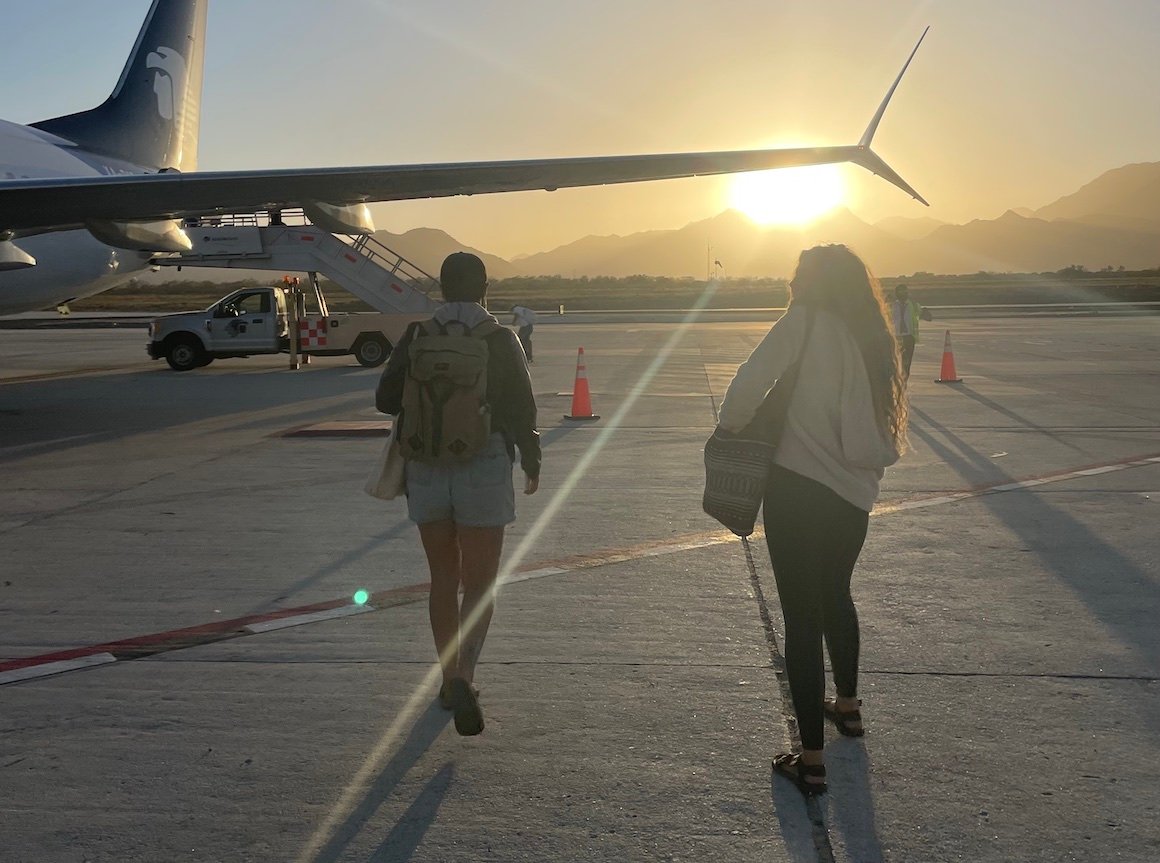
Photo: @audyscala
Athens is a short flight away, as are several Greek islands if you want to continue your Med adventure.
Europe’s budget airlines have plentiful routes to Larnaca and/or Paphos, so you can pretty much get to most EU capitals. If you didn’t have to get a visa for Cyprus, you probably won’t have to get one to go to Budapest, Bucharest, or Sofia, and if you did, your Schengen pass should have you covered.
Turkey is geographically super close but practically super far away. Thanks to the history of the island, there aren’t any direct flights, so you’ll have to transit somewhere along the way, which is a bummer when you see how close the two countries are on a map.
Cypriot Culture
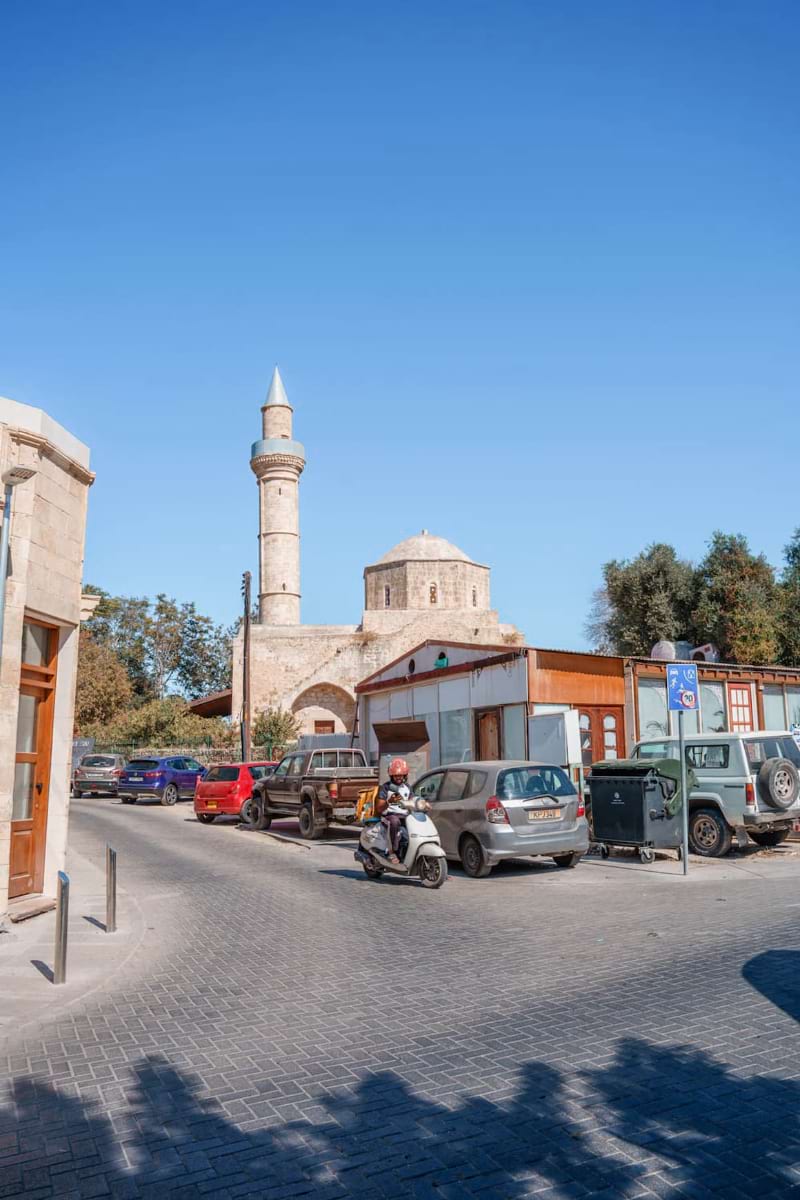
Greek and Turkish influences are the bedrock of Cypriot culture, with some overlap between the two – but don’t tell them I said that.
One major difference is that the Republic is clearly Greek Orthodox, while the North is Islamic. Both expect you to dress appropriately in places of worship.
Overall, I found everyone I met in Cyprus to be super chill and friendly. The locals have a bit of the “don’t suffer fools gladly” attitude, which means they can be a bit abrupt when they think you’re asking a stupid question, but then I’m like that most of the time anyway, so I’m here for it.
Useful Travel Phrases for Cyprus
Most people in Cyprus speak at least a little bit of English, but it’s easy enough to get brownie points with some simple, everyday phrases in Greek.
- Yassas – hello in a chill way
- Yassou – hello in a polite way
- Efharisto – thank you
- Ochi – yes
- Nai – no
- Posso – How much
- Toualeta – Toilet
- Byra parakalo – beer please
- Yamas – Cheers
What to Eat in Cyprus
Cyprus’ most famous foodstuff is halloumi, that strangely rubbery, moreish cheese that is now a protected item in Europe. Grilled, then stuffed into a flatbread or chopped up in a salad, it’s absolutely fantastic.
That’s just the tip of the iceberg for Cyprus’ delicious foodie specialities, though, which range from savory meat dishes to sweet desserts.
Must-Try Dishes in Cyprus
- Meze – A blanket term that refers to a collection of small plates. It usually includes dips like tzatziki (yoghurt cucumber) and tahini (sesame) as well as olives, flatbread, lountza (cured pork loin), and many other goodies.
- Afelia – Pork cubes marinated in red wine until they’re juicy AF. Coriander seeds give the dish its unique flavor.
- Souvla – Very similar to the Greek souvlaki, this dish is all about slow-barbecuing meat chunks (normally lamb, chicken, or pork) on skewers over coals. Smoky deliciousness.
- Loukoumades – I could have chosen many different kinds of sweets to finish with, but these fried dough balls soaked in syrup are deadly.
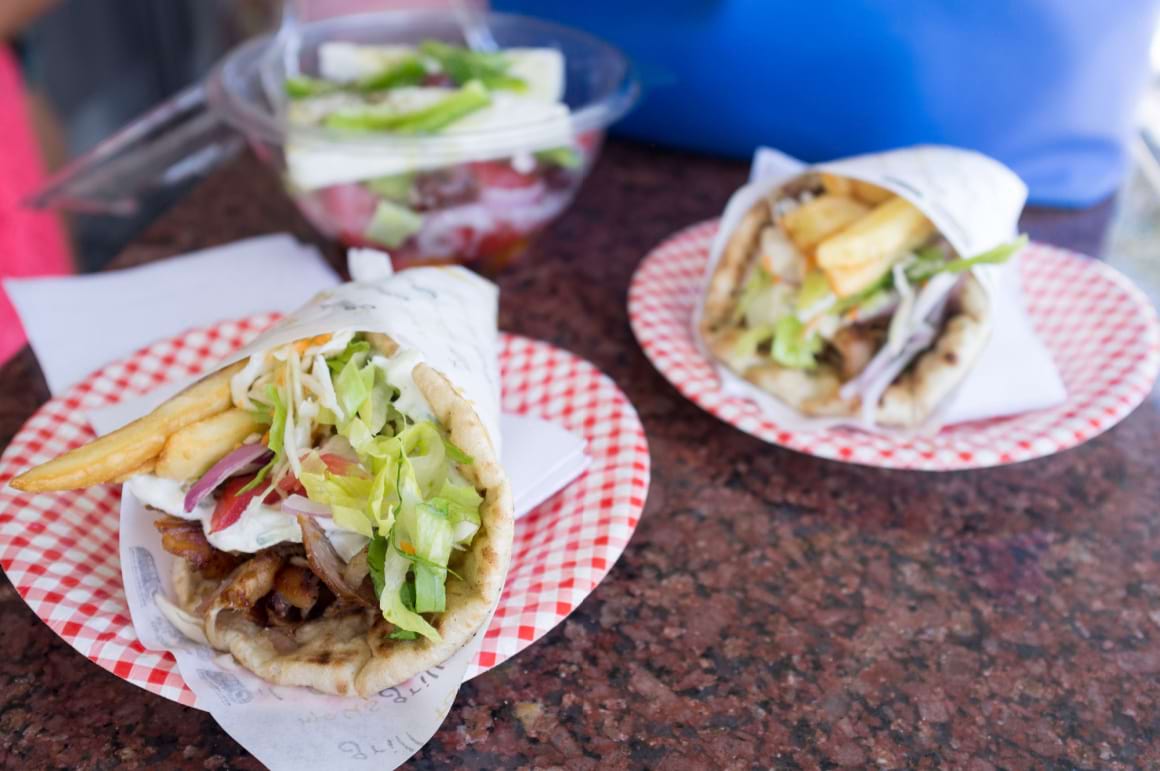
A Brief History of Cyprus
I’ve already mentioned the recent fracas between Greece and Turkey over Cyprus, but while that unfortunate piece of modern history has defined the island in recent times, the country’s roots go all the way back to the 9th millennium BC, when humans first turned up on its sandy shores.
Greeks, Phoenicians, Assyrians, Egyptians, Persians – all those guys ruled over Cyprus at one time or another, though it was the Greeks and, later, the Romans who left the most lasting influence in terms of culture and architecture from the ancient age.
Crusaders arrived to establish a foothold from about the 1100s onwards, building castles to defend the island, all of which eventually fell to the Ottomans in 1571.

And that’s how things ticked on until about the end of the 1800s, when the British took over Cyprus, first as a protectorate, then as a direct possession. They kept it for a relatively short time, relinquishing it in 1960, when it became an independent nation.
I’m not going to get bogged down in the political quagmire of what led to Turkey invading in 1974, because I’m not a historian. Let’s just say there was a lot of intercommunal unpleasantness between the Greek and Turkish populations in Cyprus that led to increasingly heated ethnic divisions, resulting in the island being sundered in two.
And that’s still where we are today.
Boom, 11,000 years of history in 235 words.
FAQs About Backpacking in Cyprus
You’ve got questions about backpacking in Cyprus, and I’ve got answers! Before you head off, ask your questions and do your research to have a more enjoyable trip once you arrive.
Final Thoughts on Traveling to Cyprus
I think people sometimes view Cyprus as one of the Greek islands – just, you know, a bit further east. And it’s true that there is a lot of Greek-influenced culture here, from the ancient ruins to the cuisine. Even the landscape looks similar.
When you’re mooching around the island though, Cyprus very much feels like its own thing. There’s an intangibly different feel to it than Mykonos or Corfu or Santorini that I wish I could put my finger on – but I can’t.
All I can say is that the memory of those quiet little hill villages, those sunsets over the western beaches, and the dramatic, crumbling castles give me a warm, fuzzy feeling that usually only comes with several glasses of wine.
Wait, maybe it’s the wine drinking that I’m remembering…
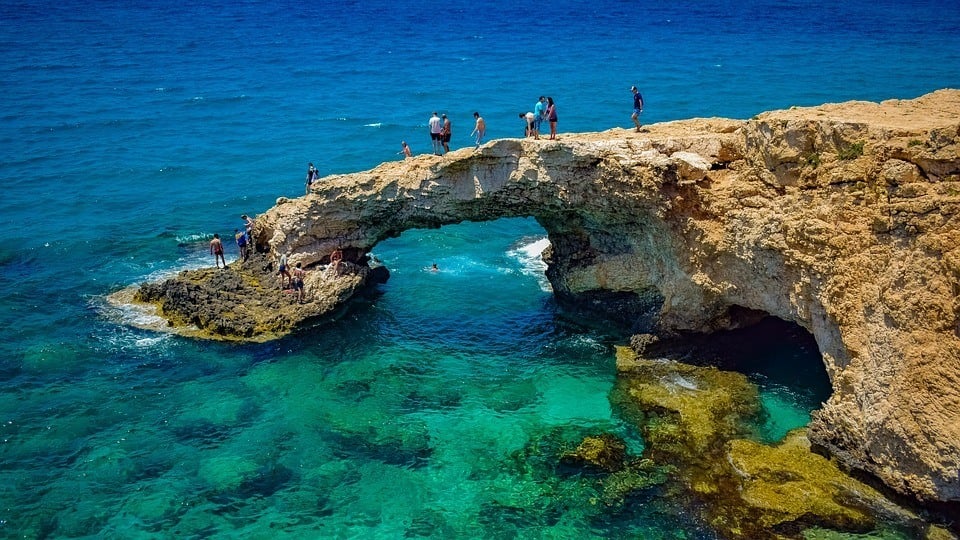
- We’ve also got where to stay in Cyprus covered with our epic guide.
- Check out the BEST hikes in Cyprus
Buy Us a Coffee!
A couple of you lovely readers suggested we set up a tip jar for direct support as an alternative to booking through our links, since we’ve decided to keep the site ad-free. So here it is!
You can now buy The Broke Backpacker a coffee. If you like and use our content to plan your trips, it’s a much appreciated way to show appreciation 🙂




